Bicycle vacation Panama
We're in the tropics: at 6:30 AM we are already on our bikes
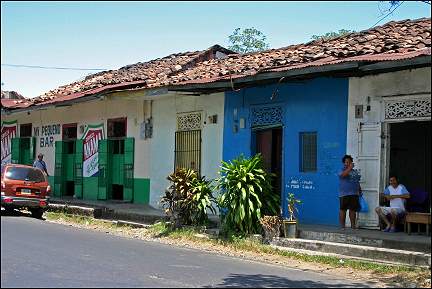
|
Every now and then we see a village in the hills. The Caribbean coast of West Panama is green and unspoiled. Off the coast lie little islands. South of the central mountain ridge it is hot and dry. The city of David is bigger than expected. Parque Nacional Volcan Baru isn't far, nor are the Pacific beaches. Via coastal towns to San José in Costa Rica.
Travelogue & photos: Gerrie & Aart Dijkzeul
The border between Costa Rica and Panama near Sixuola is indescribable. A big, filthy mud fest. The border crossing itself is a bridge that was used in the past for banana trains. It is one narrow track wide. Thick planks have been nailed lengthwise over the railroad ties.
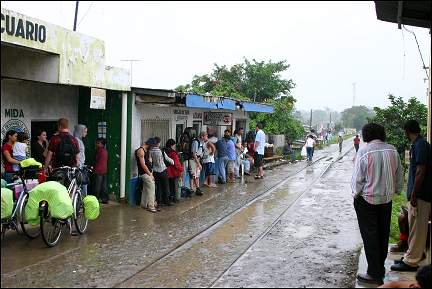 |
Pedestrians and banana trucks cross the bridge alternately. On the Panamese side the road is just as narrow and muddy. There is one customs officer in a shack, who fills out a form in neat handwriting for everyne who crosses the border.
We wait for over an hour. We depend on the officer at the desk. Finally we have the needed stamps and signature. We're in Panama.
Different country, different people. Many people in this area seems to be of Indian descent. When we take a left turn at a junction, we are told to go the other way from three different sides. So, I guess we're okay.
Along the Caribbean coast
Beautiful views of the sea and many little islands off the coast
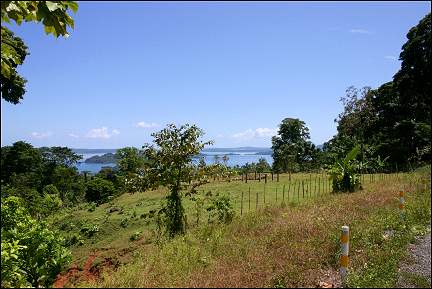 |
We leave Changuinola a little late. We're in trouble right away. On the map the color that indicates heighth is the same for all of our route: green. Nice and even, one would think. But between 0 and 600 meters apparently a lot of steep hills are possible.
We sweat, also because of the sun. There are stretches with inclines between 10-15%. When we reach 15%, our legs give out and we have to walk. But that is also strenuous. On the bright side: the road is paved, while the map said it wasn't.
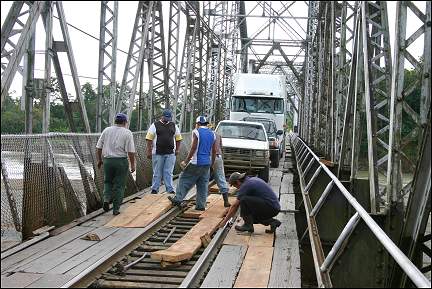 |
Almost a hundred kilometers with hardly any traffic and without any village or town. Just a few scattered houses of Indians and every now and then a hamlet of twenty or so of those houses. Everything is green and unspoiled. Sometimes we have beautiful views of the Caribbean Sea and the many little islands off the coast.
On the way there's another bridge like the one spanning the river between Costa Rica and Panama. This one is being repaired, so we have to wait until the workers, who are replacing the planks, take a break.
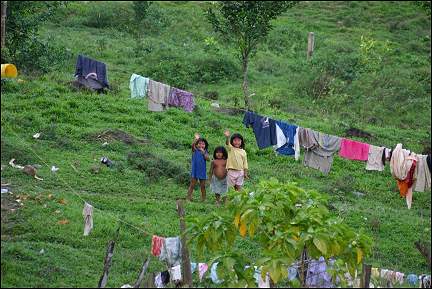 |
We arrive exhausted and somewhat queasy in Chiriqui Grande because of all the water we drank on the way. Until a while ago, before the road on which we arrived was asphalted, this coastal town was the port for the ferry to Changuinola.
Chiriqui Grande now is somewhat dull, but at least it has a hotel and a restaurant.
David
After we cross the mountain ridge, we're in a different world
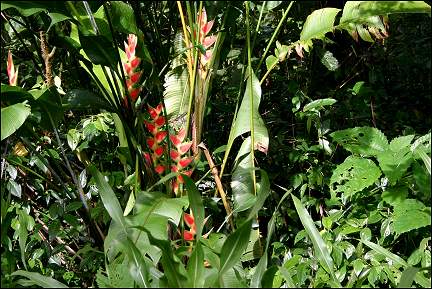 |
We take a pick-up cab for the trip over the mountain ridge to David. The pattern of colors for heighth on our map and what we hear from locals, tell us that it's beautiful up there, but not fun to bicycle.
When we arrive on the other side of the mountain ridge we're glad we did this. Kilometers long stretches where the car has to go in 2nd gear and at the top it's cold and wet and there is a strong wind. But it is indescribably gorgeous. Wild overgrowth, water dripping along vertical walls of rock, waterfalls and creeks. Landslides here and there. It's breathtaking.
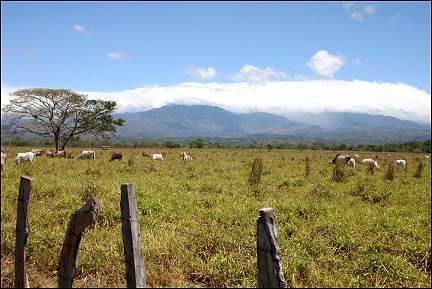 |
One we've crossed the mountain ridge, we're in a completely different world. Relatively even, hot and dry. On the Caribbean side even in the dry season it still rains 200 mm per month; on the Pacific side it doesn't rain at all for a couple of months around the new year.
We bicycle for some 40 kilometers through a cattle farming and agricultural area and then we arrive in David. This area provides all of Panama with vegetables, meat and dairy.
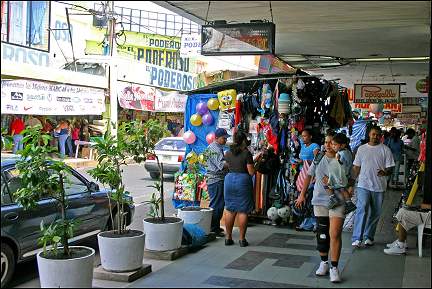 |
In David we visit the Anguizola family, where our daughter Dorrith spent a year. We formed an image in our minds of this town based on Dorrith's stories and photos: something like the other towns we visited on this trip.
It's interesting to find out that our image was totally wrong. It's not a small town at all. It starts with the signs we see along the Panamerican Highway: Urbanico Centro 1 km. The town center is busy and has the style of a city. Shopping streets, banks, hotels, a park with a church and other things that make a city a city.
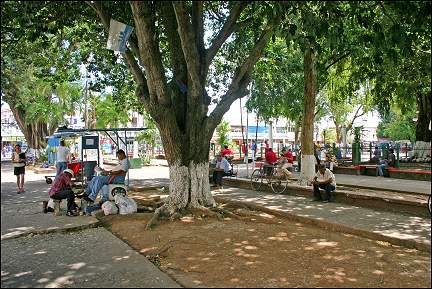 |
The next few days we'll have time to experience the "Dorrith feeling." Except that we're together and she was all alone in a strange city with a completely different culture and she didn't speak the language.
On Sunday we visit the Anguizola family. After having checked the description of all the family members, we look for 8, Calle Octava.
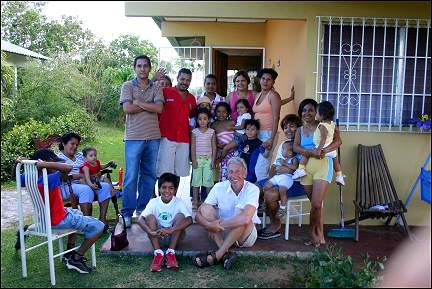 |
That isn't easy. No house numbers and only in the center of town the streets have street signs. We ask around and learn that the house numbers go up starting from the center.
If you loose your count, you have to go back to the center and start counting again. Or ask.
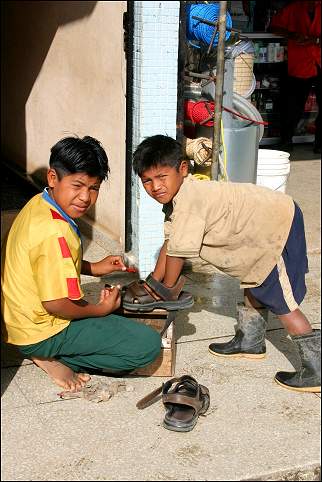 |
In Calle Octava the grocery store owner knows where the house is that we're looking for. We're warmly welcomed by Lucy, Ulises, Francisco and other family members. Only Francisco speaks a few words of English. Gerrie's Spanish course turns out to be useful.
We have a great afternoon, chatting about Dorrith, our trip and soccer.
Before we know what's happening, Francisco has made plans for the rest of the day and tomorrow. He wants us to stay with them as well; it's hard to refuse, but we do. It's very sweet, but we remember Dorrith's stories about sharing a room with Grandma and Rosita and all the noise around the house.
With seven of us in the PC Cabeza tractora we first drive to Francisco's relatives. They all want to meet Dorrith's parents. Many names, lots of "Ola!" and "Bienvenido" and Spanish we don't understand. Family ties are strong here and very warm. Back in the car and to Lucy's and Francisco's house.
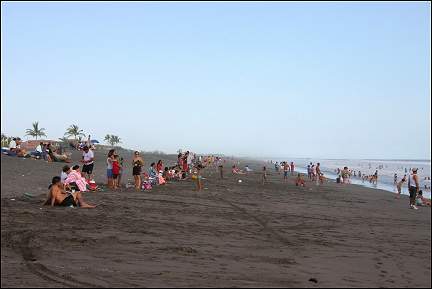 |
Then we race to the beach, thirty odd kilometers from David. Kilometers of sand with a few reed shacks and a little restaurant where we eat fish. It's delicious. We take a quick, very short walk and Francisco starts the car already to go home.
Tomorrow's plans are more concrete now. We'll take a walk in the volcano area of Baru National Park, at a 70 km distance from David, which we meant to do anyway with just the two of us. Around 8 PM we bicycle back to our hotel, completely exhausted. An afternoon with Francisco and his family, who we understand only partially, turns out to be more exhausting than bicycling in the mountains.
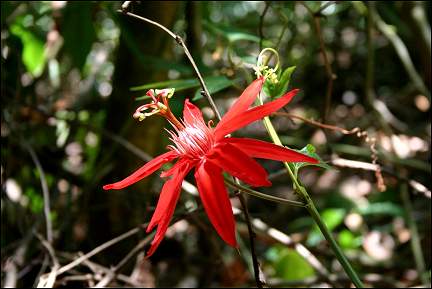 |
Next morning, a little after 6 AM, when it's still dark, we're on the bus with Francisco and Ulises to Cerro Punta. It's quite an experience, this bus trip. It's different from what we're used to and completely privatised.
The bus, a small one for a maximum of 30 passenters, stops at almost every big tree. Even if there are only ten meters between one and the next. Because of this the trip takes two and a half hours. We pay only 4 dollars, so what are we doing in this country with our bikes?
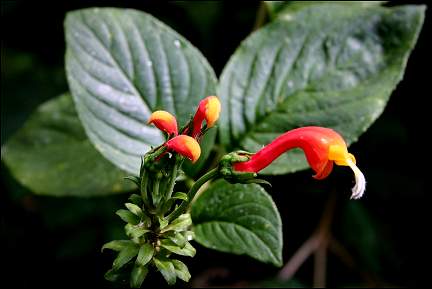 |
The hike is magnificent. Trees, plants, flowers, birds: everything is so exotic. For six hours we climb and clamber, usually in a line. It's physically taxing. At the end of our hike, we're relieved to see Lucy waiting for us with their car.
In the evening there's a dinner in our honor at the Anguizola residence. The good china is brought out, with wine glasses. Unfortunately, the wine stays in the bottle: nobody knows how to use the corkscrew, a present from a business relation.
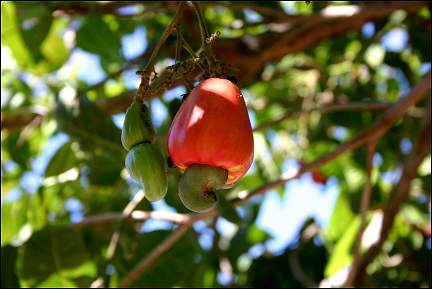 |
Ulises teaches Gerrie how to fry Platanos, a Latin American specialty. It's tasty.
Fransisco tries to make us extend our stay in David, but we have to say goodbye.
Coastal towns along the Pacific
A dive in the sea rids us of sweat
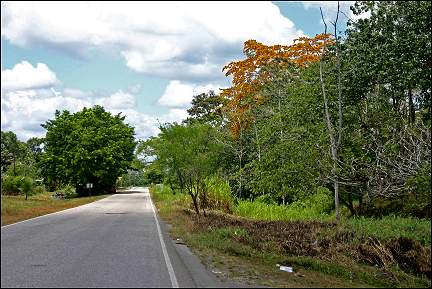 |
At 6:30 AM next morning we're on our bikes again. For the next two days, we'll be bicycling on the Panamerican Highway, which turns out to be pretty and quiet.
Via Ciudad Neily (just past the border in Costa Rica) we arrive in Palmar Norte. We don't have a lot of options for the route from Palmar Norte to San José in Costa Rica: it's either the Panamerican Highway (which sounds scarier than it is, at least when you're not near a big city) or the coastal road, which we take.
For the next three days we ride our bikes over rolling hills, stay overnight in a beach resort and in the evenings swim in the Pacific. And we're lucky: the road just had a new topcoat of asphalt. Smooth asphalt (except for the bumps formed by thousands of crushed lobsters) and easy hills: we can look around us all we want. Which is pretty much the only thing you can do on a bike anyway.
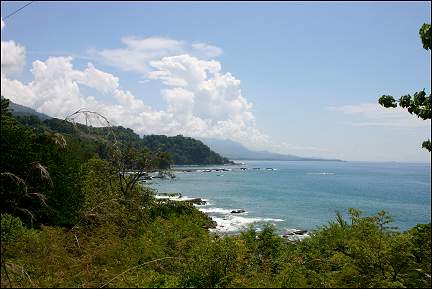 |
Just like every other day, we reach our destination of today around noon, when the temperature has risen to 35 degrees Centigrade. It is Dominical, our first coastal town. A swim in the ocean rinses off the sweat.
Dominical is no more than a sandpath with a few restaurants, cabanas and a supermarket. A beautiful beach, clear water and the beach tourists can be counted on one hand. Reason for us to stay a little while longer. Finally we see a few toucans.
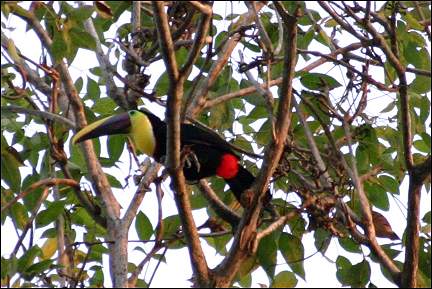 |
The ride to the next town, Quepos, is literally and metaphorically shocking. We expected a smooth road. But it turns out to be a path, consisting of gravel, potholes, bumps and other obstacles.
For forty-five kilometers we bump at a speed of not faster than 10 kph. It costs us a broken spoke and damaged outer tube. Luckily we have brought spare everythings. There are no other problems, but we can't look around, because we need to keep focused on the road.
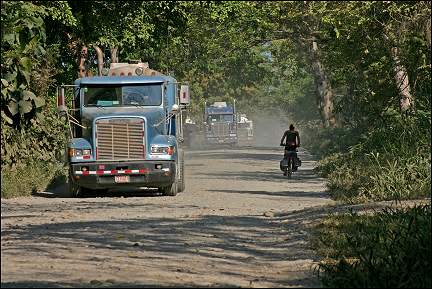 |
Quepos is a relatively big beach resort. The coast is rocky here. It's impressive to see the ocean beat the rocks. The small stretch of beach is, according to the Lonely Planet, too filthy to use. Only locals swim here.
The town stinks. Garbage and open sewers everywhere. When we're having breakfast in the morning, we see a rat walking on a ridge. We both feel queasy all day long. Fortunately this is an exception; usually towns and villages are reasonably clean.
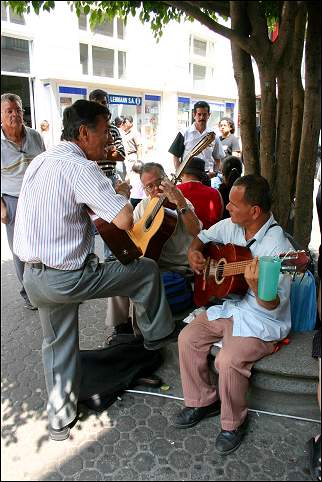 |
The last town on the Pacific we visit is Jaco, a tourist resort with everything one can expect.
From Quepos we take a bus to San José, Costa Rica. For two dollars a head and two for the bicycles which we leave in the luggage compartment, the hundred kilometers to Costa Rica's Central Plain are covered. It's perfect to be able to take your bike with you on the bus. The owner of the pretty yellow bag which was constantly swept against the chain of my bike clearly feels differently.
We spend the last two days in San José wandering around. We visit a church, a market, look at old buildings and people. We attend a performance of La Traviata, because you haven't really been in Central America if you haven't seen and heard this Verdi masterpiece.
And with this the imaginary eight which we have bicycled through Costa Rica and Panama is closed. We have covered 1800 kilometers in 23 stages. 1500 by bike, the rest by bus and car. We have spent the nights in as many villages and towns. Beautiful nature, friendly people, freedom: we had a fantastic time.